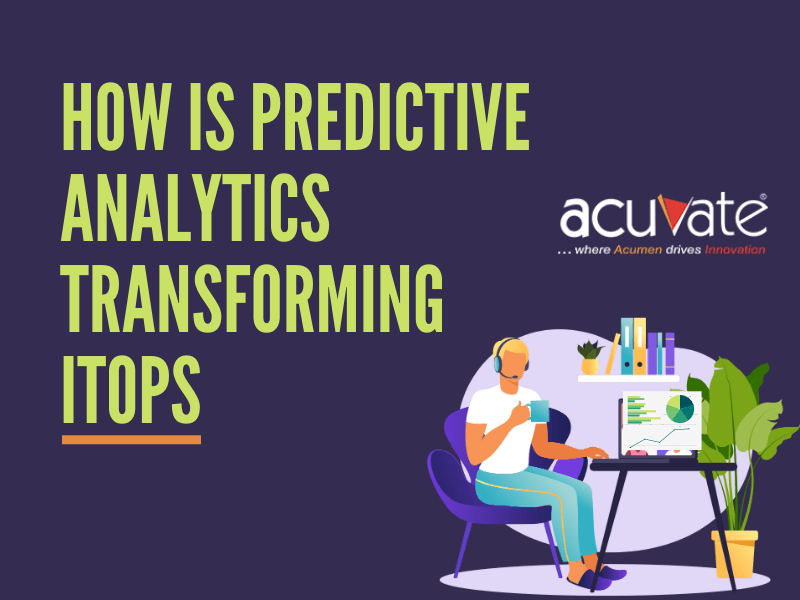Predictive Analytics: An evolution in IT
Today’s IT operations monitoring and management systems leverage predictive analytics for collecting and integrating data, normalizing it, and analyzing it in real-time.
Machine learning algorithms analyze past incident data to predict and resolve potential incidents in the future.
Here are some ways in which predictive analytics is transforming IT operations.
1. Dynamic thresholding and anomaly detection
An anomaly detection algorithm uses unsupervised machine learning to get familiar with the IT environment, recognize expected behavior, and set dynamic thresholds against vital performance metrics.
Consequently, event patterns are analyzed in real-time and compared against expected behavior, and the IT team is alerted when a series of events showcase anomalous activity.
Moreover, fuelled by artificial intelligence, the system also accounts for false alert suppression and seasonality, i.e. alerts are sent only when a critical application displays abnormal behavior during an unexpected time period. For example, a 90% system utilization is normal during peak business hours, but indicates an issue when the same metric is hit on a Sunday morning.
Anomalous group of events are helpful in –
- Alerting the team regarding an unplanned activity, for example a cyber attack
- Making IT operations more agile by improving planning for significant events, for example, Amazon increasing capacity to ensure infrastructure and applications perform well during the ‘Big Billion Sale’.
2. Predictive maintenance of application health in real-time
Performing application health monitoring in real-time allows ITOps teams to respond to a degradation in application health before operations come to a standstill.
Available data generated by the application, including configuration data, network logs, application logs, performance logs, and error logs, is compiled. Multivariate machine learning techniques analyze this data, across different dimensions, to learn the application’s normal behavior.
As new data enters the application, the model identifies unusual patterns and sends it to the IT personnel to follow up before a business-critical outage takes place.
3. Predict network downtime using sequential pattern analysis and time-series event correlation
A survey by an AIOps Exchange states, “45% of businesses are using AIOps for better root cause analysis and to help predict potential problems.”
Thousands of events across applications and infrastructure are correlated in a time series and analyzed by an ML-powered algorithm to identify patterns.
These patterns proactively alert the team regarding any potential outages and network downtime, reduce the quantum of alerts and pinpoint the root cause, and understand the future impact of similar patterns being repeated.
4. Predict and prevent common capacity issues
Machine learning algorithms analyze historical utilization trends of infrastructure resources, including CPU, memory, etc. to predict capacity exhaustion.
Predictive analytics ensures more bandwidth can be added via automation or manual intervention, so no resource becomes non-operational due to capacity issues.
Moreover, organizations may purchase additional capacity and reserve instances in advance, to cope with the additional demand, leading to large cost savings.
5. Ensuring cybersecurity by detecting fraud
The use of predictive analytics in detecting fraud has gained prominence in ensuring cybersecurity. ML-enabled tools analyze typical fraudulent activity, recognize patterns, and find anomalies.
Continuous monitoring of IT systems leads to early detection of any potential fraudulent activity.
Get Started
Driven by powerful technologies, predictive analytics helps organizations improve responsiveness to events, system health, productivity, and efficiency.
It’s ability to study historical data and make predictions allows enterprises to proactively tackle issues with a speed that was unimaginable before.
So, here are a few recommendations to help you get started with predictive analytics –
- Centralize data to the extent possible , allowing for easy cleansing, normalization, and a single, cohesive system of records for all users.
- Invest in user-friendly data visualization tools that use easy-to-read dashboards and charts to explain the trends and correlations that the system discovers.
- Ensure your IT operations systems are intelligent, automated, and actionable. Predictive data is meaningless unless it is acted upon at the right time.
- Update your IT team’s expertise with skills in data science, machine learning, and AI-driven analytics.
At Acuvate, we provide clients services in predictive maintenance on application and infrastructure to optimize operations and ensure uptime. Acuvate along with its IP has expertise on multiple industry leading ITOps tools and leverages the expertise to ensure our clients IT infra is in the right shape and ready for business demands .
To know more, please feel free to schedule a personalized consultation with our AIOps experts.



